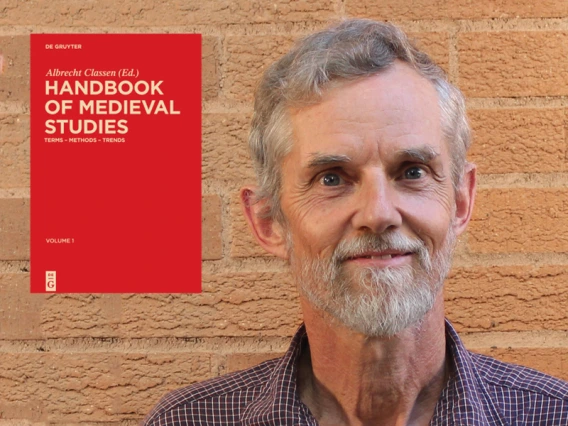
UA Distinguished Professor Albrecht Classen has edited a three-part reference volume meant to provide readers with a broad understanding of contemporary research in medieval studies. Albrecht Classen set out more than six years ago on a major effort to compile a reference handbook about contemporary research on medieval studies.
During that time, Classen, a University of Arizona professor, developed and strengthened international ties with researchers, gathered articles and manuscripts and managed an expansive Website of worldwide resources. He has since completed the project, resulting in the three-volume Handbook of Medieval Studies, providing an in-depth and interdisciplinary overview of the expansive research in the field covering the last 150 years. "From now on, there is nothing that can be seen in isolation," said Classen, a University Distinguished Professor in the German studies department.
"Any future researchers must be confronted with this huge number of relevant studies since all aspects in the Middle Ages have to be studied from an interdisciplinary, comparative perspective," he added. The handbook, which is also available electronically through the UA Libraries, may become a foundational reference work for the field and serves to plainly express the extensive synergies that exist within it. "It is absolutely a demanding global international interdisciplinary research field of greatest fertility," said Classen, editor of the series published in December by DeGruyter, which has offices in New York and in Germany.
Initially, the DeGruyter's editor-in-chief approached Classen about editing a volume. "The publisher trusted me to have the energy, the global view and the connections to as many disciplines as possible," Classen said. "The handbook is relevant for virtually every aspect in my field." That goes for architecture, art and art history, language, medicine, music, religion, technology and other areas – all of which the handbook addresses. Classen noted that other strong reference works already exist, but the voluminous handbook serves as a century work, providing insight into the history of research. "It just grew and grew and, in a way, we were trying to capture an entire world, but through the lens of scholarship," he said, noting that the research field began as early as the 1770s. "But this is the first major reference work that takes stock of everything we have done so far."
In its publicity material, DeGruyter noted that the handbook "enables the readers to quickly and purposely gain insight into the important research discussions and to inform themselves about the current status of research in the field." All told, the volumes "exhaustively documents the current status of research in medieval studies and brings the disciplines and experts of the field together," DeGruyter also noted.
The Handbook of Medieval Studies is comprised of four sections:
- The first is full of articles on a broad range of discussions in the field.
- The second focuses on key concepts.
- The third provides an overview of some of the most critical genres during the Middle Ages.
- The last section provides international bibliographical and information on some of the most visible medievalists in all medieval studies disciplines.
Classen's work complements a number of other efforts at the UA to elevate the status of medieval studies. The UA's Special Collections announced in December that it acquired a major collection of medieval works previously held by Heiko A. Oberman. Also, the UA's Division for Late Medieval and Reformation Studies announced the culmination of a $2 million fundraising effort to endow the Heiko A. Oberman Chair in Late Medieval and Reformation History, which is currently being held by Ute Lotz-Heumann. In fact, Oberman founded the UA division more than 20 years ago for the purpose of advancing Reformation study.
Also, Classen teaches "Eroticism and Love in the Middle Ages” and "Medieval Answers to Modern Questions," classes that compliment wide variety of other courses offered across campus focusing on medieval art, architecture, literature and history. For the handbook, it took two years alone to develop an adequate list of the field's major contributors and researchers – individuals laying the foundation for contemporary research. Compiling such an expansive amount of information proved to be "very, very difficult" but that it also proved to be "a labor of love," Classen said.
His Website allowed individuals around the world to suggest categories, topics and themes to cover, which Classen then followed up on for development. "This made it particularly difficult because research today is without bounds," he said. "I hope this handbook will show the dedication I have for the field," said Classen, adding that he will be incorporating the reference work in his courses and is striving to coordinate a meeting of the handbook's contributors for later this year in Venice, Italy. "I am just very excited about it. It was so amazing," he added. "Now I hope for more interaction among scholars and for more productivity in our field. This handbook sets new standards and will be the benchmark for all future research in our field on a global level, and this created here at the University of Arizona."
Copyright: La Monica Everett-Haynes, University of Arizona Marketing (UANews)

